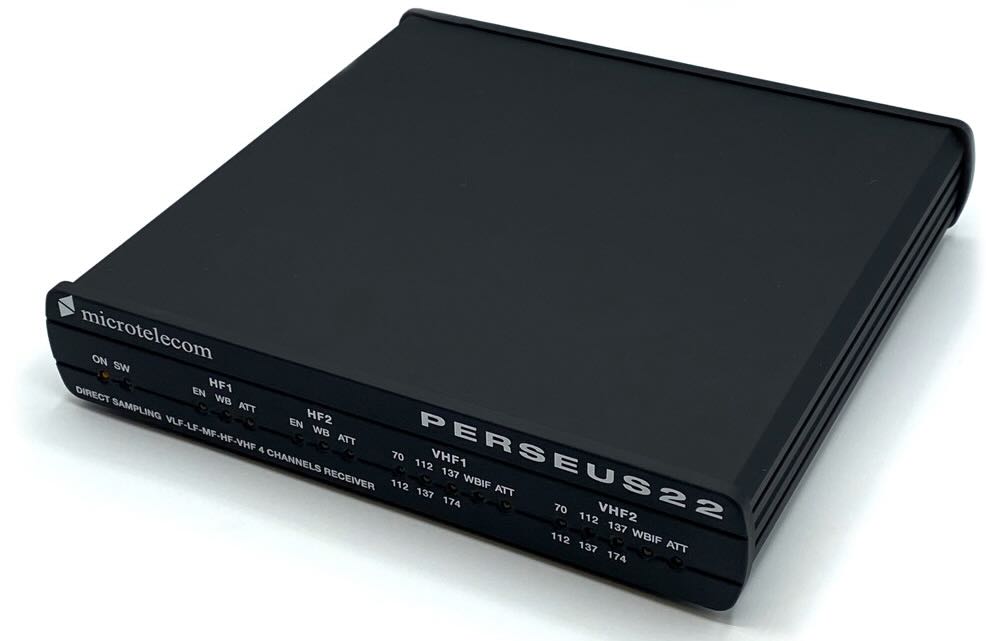Microtelecom has just announced their latest SDR receiver: the Perseus22.
INTRODUCING NEXT-GEN SDR RECEIVER
Perseus22 is a 4 channels, direct sampling receiver with a continuous frequency coverage from 10 KHz to 225 MHz and a typical image rejection larger than 70 dB.
All channels are synchronously sampled by an high SNR, 14 bits A/D converter and processed by a software defined digital down converter, implemented on an FPGA, which outputs are routed to the host PC by a USB 3.0 controller, allowing wide-bandwidth IF applications.
The frequency coverage is split-up in 2 groups of channels (two for VLF-HF frequency range, the others for VHF), each one capable of diversity, which can reduce noise in order of tens dB. All channels includes an analog RF frontend equipped with attenuators, preselection filters and amplifiers.
The receiver enclosure is machined from solid aluminium and finished with a fine, non reflecting, black surface treatment.
I’ve no other details at present, but I’m eager to learn about pricing and availability.


https://www.eladit.shop/en-gb/Ricevitore-Perseus22-p567316848
2.427 Euro
The dynamic range difference between a 14-bit ADC and a 16-bit ADC is minimal due to ENOB.
If done correctly, there is nothing wrong with undersampling. The IC-9700 undersamples on 2m and 70cm, and on 23cm downconverts to 300 MHz which is also undersampled.
I’ve seen a price of roughly $1,500.00. Ooops! I don’t care how good it might be. That’s way TOO much.
14 Bit 🙁
No need to buy this receiver.
I am verry happy with my Elad FDM-S3 and Reuter RDR52.
If the Perseus 22 goes for 1500USD you are better of with the Elad or Reuter receivers.
73
Jacco/NL11673
RonF
Nyquist Theory cannot be ignored. https://www.techtarget.com/whatis/definition/Nyquist-Theorem#:~:text=The%20Nyquist%20theorem%20is%20also,and%20video%20to%20reduce%20aliasing.
Nobody’s ignoring Shannon-Nyquist, Alan. Maybe try reading the appnote I mentioned (SiLabs AN118), or some other explanation of oversampling vs bit depth/resolution/dynamic range – you might learn something new to you!
>Still just 14 bit. Not worth the money!
You should compare the ENOB (Effective Number Of Bits) if you know what it means.
Your comment makes me think you are not a guru in the area.
Software Designed Radios convert the incoming signal from analog to digital and then a specialised computer filter and demodulate the signal. Then if the transmission is digital it will store, error correct and convert the signal to analog sound. The data is sent to a display.
A 14 bit converter produces a signal for 16384 levels of voltage. A 16 bit converter produces a signal for 65536 levels. A 16 bit converter can handle a larger range of signal strength with lower distortion of the sound.
Still just 14 bit. Not worth the money!
Explain that!
Ready to buy, $? ASAP
Yes I’d love to hear more as well. What’s the practical result of more bits? How many are required?
I will explain it: each bit increases the dynamic range by 6 dB. Doubling the sampling rate brings 3 dB. But is that necessary? Nico Palermo knows what he’s doing and the data speaks for itself. In addition, the Perseus would become even more expensive (at the Ham Radio in Friedrichshafen, Germany, Elad/Microtelecom quoted a price of around 2000 to 2500 euros for the Perseus22).
As long as the sample rate is at least 2.5 times the highest frequency you are tuning sample frequency is irrelevant. Between 2.2 – 2.5 times needs a good input filter
> As long as the sample rate is at least 2.5 times the highest frequency you are tuning sample frequency is irrelevant.
Not irrelevant. As they said, increasing the sampling rate (and oversampling + averaging) improves the ENOB (resolution) by ~3dB per doubling (albeit at the cost of sampling bandwidth).
It’s a pretty common method in practice (and worthwhile even if you’re using a high-resolution ADC, since their base ENOB is always less than their actual number of bits e.g a 14-bit ADC will typically only have 12~13 actual worthwhile bits of resolution). If you’re really interested in learning about the idea and not just bloviating as usual, SiLabs have a nice application note (AN118) that explains the concept fairly simply.
well, if so, pick an ettus sdr 😀